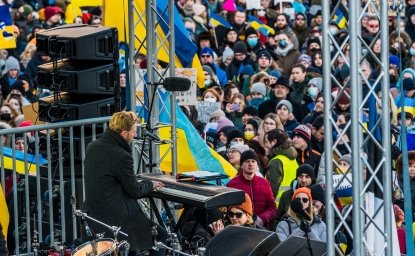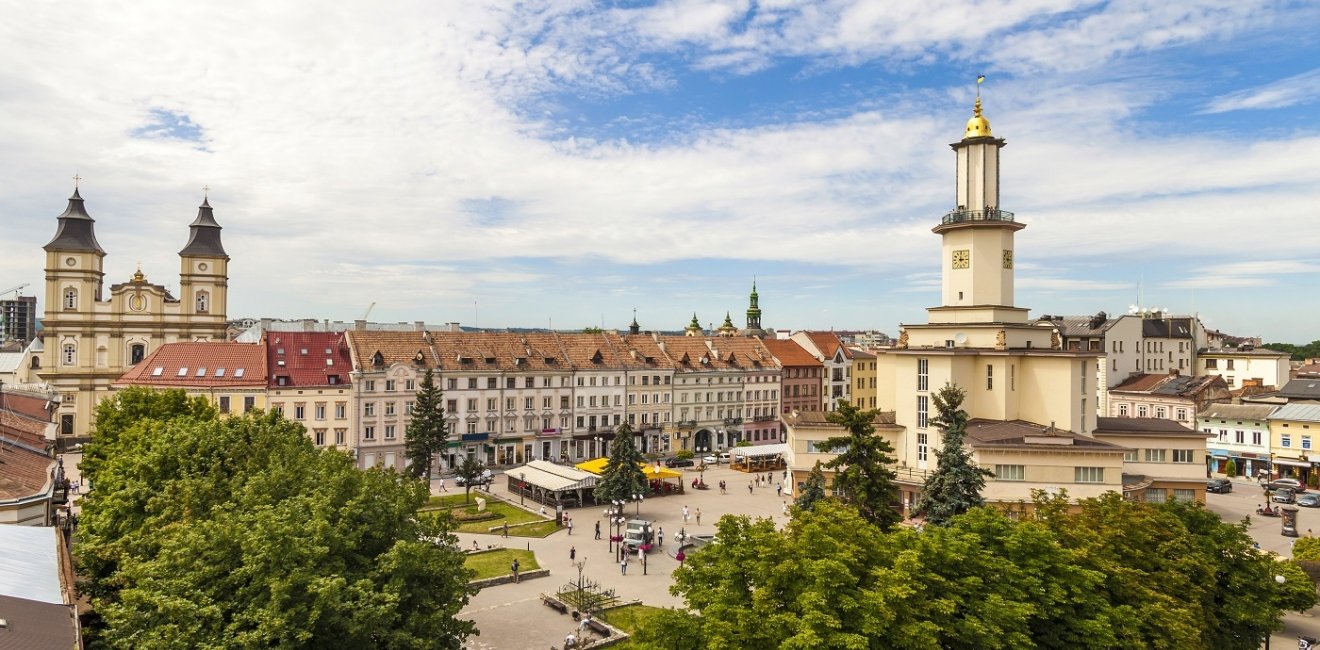
A blog of the Kennan Institute
BY BLAIR A. RUBLE
In 2014, arts administrator Alona Karavai fled west as Russian-supported separatists overran her hometown of Donetsk. Karavai ended up in Ivano-Frankivsk, a city nestled in the Carpathian foothills, where she opened the gallery Assortymetna Kimnata (Assortment Room). She joined with local artists to form a collective community which shares living and working space. A network of modernized traditional mountain cabins eventually spread throughout the region. Modeled on German “artist houses,” the collective supports artistic work and links its members together.
The full-scale Russian invasion of Ukraine in 2022 forced the community members to expand their reach. Lesa Khomenko, who facilitated support for young artists in Kyiv and linked Karavai and her colleagues to important partners in the capital at the Center for Contemporary Art at Kyiv-Mohyla Academy, fled Kyiv and joined the Assortymetna Kimnata group.
Facing the uncertainties of war, the group expanded its activities to provide sanctuary for artists fleeing their homes in the east, offer safe haven for work that was being evacuated, raise funds to help support the evacuated artists and their work, and create an internet presence for the artists that reaches beyond Ukraine’s boundaries.
To date, the community has provided homes for 18 artists and works with around 30 artists in the region. It has organized virtual and physical shows. It has archived some 600 works brought from endangered cities, like the 200 items, for example, returned as the Ukrainian army drove out Russian occupation in Kyiv and Kharkiv. The gallery has deepened relations with international partners, such as the Network of Northern German Art Houses (Netzwerk der Künstlerhäuser Norddeutschland, or NKN).
Ivano-Frankivsk, like the Transcarpathian city of Uzhgorod discussed in an earlier posting (January 10, 2022), has a long and complex history. Several international boundaries have crossed back and forth over the town since its founding as the 17th century fortress of the Polish Potocki family. Known by various linguistic variants of Stanisławów over the decades, the town became part of the newly independent Poland in 1921. The town’s architecture remains a delightful blend of these various incarnations.
The town served as a regional center of around 50,000 during the inter-war era, with some 40 percent of its residents being Polish; another 40 percent, Jewish; and the remainder predominately Ukrainian. The Jewish population was largely exterminated during the war and the Poles were forced to migrate to Poland after the war. Soviet authorities marked the town’s tricentennial by renaming it in honor of Ukrainian writer Ivan Franko. The city’s 240,000 21st century residents have taken the short form “Franyk.”
Since Ukrainian independence, the city has become a hub for rustic tourism celebrating traditional crafts and culture. Local entrepreneurs developed hiking trails and services, including picturesque log cabins, to host visitors from the country’s metropolitan centers. Karavai and her partners have hired local households, from Assortymetna Kimnata’s inception, to provide room and board for visiting artists. Initially, both rural host and big-city guest seemed exotic to one another. Over time, relationships have formed among these groups. These ties have added to the artists’ appreciation of rural customs and culture, enriching their creations.
At present, the collective has a large apartment in town with a cellar and storage rooms, with additional studio space in a nearby private art school that closed when the war began. It also offers links to rustic sanctuaries in the surrounding countryside. Providing living and working space in a region of Ukraine that remains relatively untouched by war, this initiative provides an important retreat for artists, whose imaginations offer a vibrant response to the physical destruction elsewhere in Ukraine.
The opinions expressed in this article are those solely of the author and do not reflect the views of the Kennan Institute.
Author

Former Wilson Center Vice President for Programs (2014-2017); Director of the Comparative Urban Studies Program/Urban Sustainability Laboratory (1992-2017); Director of the Kennan Institute for Advanced Russian Studies (1989-2012) and Director of the Program on Global Sustainability and Resilience (2012-2014)

Kennan Institute
After more than 50 years as a vital part of the Wilson Center legacy, the Kennan Institute has become an independent think tank. You can find the current website for the Kennan Institute at kennaninstitute.org. Please look for future announcements about partnership activities between the Wilson Center and the Kennan Institute at Wilson Center Press Room. The Kennan Institute is the premier US center for advanced research on Eurasia and the oldest and largest regional program at the Woodrow Wilson International Center for Scholars. The Kennan Institute is committed to improving American understanding of Russia, Ukraine, Central Asia, the South Caucasus, and the surrounding region through research and exchange. Read more

Explore More in Focus Ukraine
Browse Focus Ukraine
The Arts of War: Ukrainian Artists Confront Russia

Talking to the Dead to Heal the Living

Ukrainian Issue in Polish Elections

